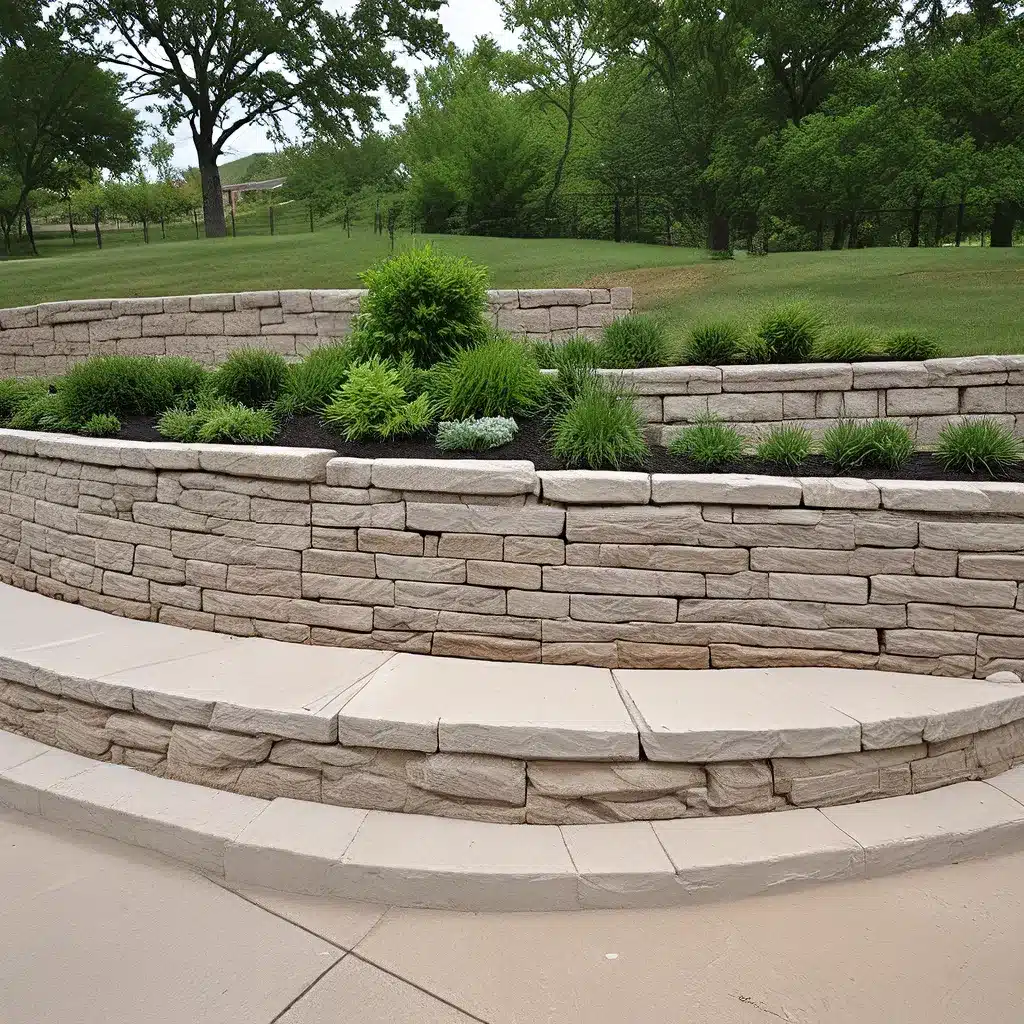
The Foundations of Strong Retaining Walls
In the vibrant heart of Kansas City, MO, where the landscape is as varied as its culture, retaining walls have evolved from mere functional elements to integral parts of many outdoor spaces. But what ensures a retaining wall’s longevity? The secret lies in the foundation.
Achieving a compact and solid base is paramount for a resilient retaining wall design. Techniques vary from using manual tampers for smaller areas to employing heavy machinery, like plate compactors, for larger projects. These specialized tools ensure the ground is uniformly compacted, providing a robust foundation for the wall materials.
The stability of a retaining wall design also hinges on its anchoring. A wall with components that anchor it deeply and securely stands a better chance against external pressures, such as the lateral earth pressure exerted by the soil it’s designed to hold back.
Mastering the Art of Retaining Wall Design
Before you even start brainstorming retaining wall ideas, it’s essential to thoroughly understand your site. This means conducting soil testing and analysis to determine the type of soil you’re working with. Some soils might exert more lateral earth pressure, while others could be more prone to erosion.
Once you’ve gathered this crucial information, it’s time to clear the area of any vegetation and obstacles. This ensures your wall has a solid foundation, free from potential weak points essential for a strong retaining wall design.
Bringing your retaining wall idea to life isn’t just about stacking materials. It’s an intricate blend of art and science. Your design should consider factors like wall thickness, height, and the maximum soil-bearing pressure it will face. Remember, every site has its unique challenges, and your retaining wall design should be adaptable to address them.
Maintaining the Strength and Beauty of Retaining Walls
Even the mightiest of retaining walls need regular check-ups. Retaining wall maintenance is important for keeping your investment functional and aesthetically pleasing. Make it a habit to inspect your wall for signs of wear or damage, and address any issues early on.
There are numerous techniques available, from adding more blocks to adjusting the wall’s thickness, to ensure your retaining wall stands tall for years to come. By staying proactive, you can save yourself a lot of headaches down the road.
Local Considerations for Retaining Walls in Kansas City
Nestled in the heartland of America, Kansas City, MO, boasts a unique blend of urban charm and natural beauty. But when it comes to retaining wall design, there are specific local considerations every homeowner should be aware of.
The weather in Kansas City swings between sizzling summers and frosty winters, demanding a retaining wall that’s prepared for every season. One significant challenge is the freeze-thaw cycle, which can be particularly harsh on walls that aren’t built with this in mind, leading to potential cracks and structural issues.
Furthermore, Kansas City gets its fair share of downpours, making it vital to have a retaining wall design that incorporates proper drainage systems. This ensures the wall can handle the moisture and reduces the risk of water damage and soil erosion.
It’s also crucial to be aware of the local rules and regulations. Every city has its standards, and staying compliant is crucial for the safety and longevity of your retaining wall.
The Dual Purpose of Retaining Walls
The importance of retaining walls is two-fold. A retaining wall creates more than just a functional addition to outdoor spaces; they’re a blend of engineering and art, especially in the diverse landscapes of Kansas City, MO.
At its core, a retaining wall’s primary function is for soil retention and erosion prevention. By retaining soil, especially in sloped terrain, retaining walls ensure it remains in place and prevent erosion. This not only safeguards your property but also creates level surfaces for gardens or patios.
Beyond their functional role, retaining walls can also be a sculptural element in your yard. Whether it’s a stone retaining wall or a vertical garden, the right design can elevate the beauty of your outdoor space.
Choosing the Right Retaining Wall Material
From natural stone to concrete blocks, the choices for your retaining wall design are vast. Each material has its pros and cons, and the best retaining wall material for you depends on your specific needs and aesthetic preferences.
The local climate, the amount of lateral pressure expected, and even your budget can influence your material choice. For instance, a gabion wall might be ideal for those looking for a blend of functionality and rustic charm.
Selecting the Optimal Retaining Wall Type
When it comes to retaining wall design, one size doesn’t fit all. Depending on the challenges posed by your property and your aesthetic preferences, you might opt for one type of retaining wall over another.
Gravity walls, cantilever walls, and reinforced soil walls are just a few of the options to consider. Understanding the unique benefits and drawbacks of each type can help you determine which retaining wall is best for your needs.
Avoiding Common Retaining Wall Failures
To ensure your wall stands the test of time, it’s essential to be aware of the common causes of retaining wall failures and how to avoid them.
Inadequate foundations, insufficient reinforcements, and improper drainage are among the leading culprits of retaining wall failures. By addressing these issues during the design and installation process, you can safeguard your investment and enjoy a sturdy, long-lasting retaining wall.
Partnering with Experts for Retaining Wall Excellence
At Concrete Contractor Kansas City, we bring years of experience in crafting walls that are not only aesthetically pleasing but also engineered for longevity. From the initial design phase to the final brick placement, we’re with you every step of the way.
Whether you’re looking to prevent erosion, create level surfaces, or simply elevate the aesthetics of your outdoor space, Concrete Contractor Kansas City is here to help. Contact us today, and let’s transform your property together.

